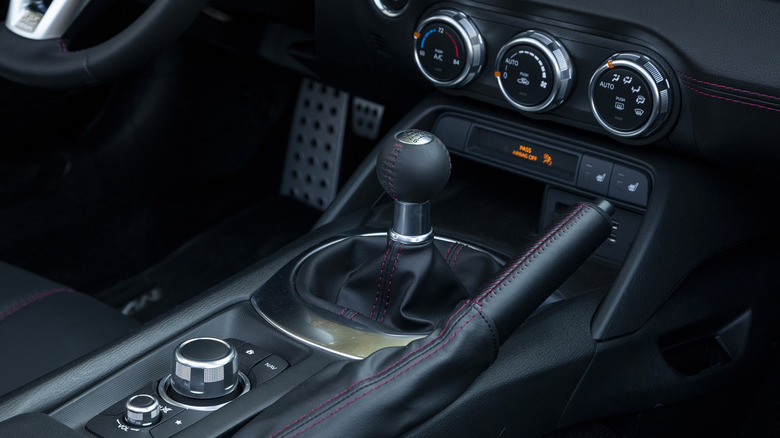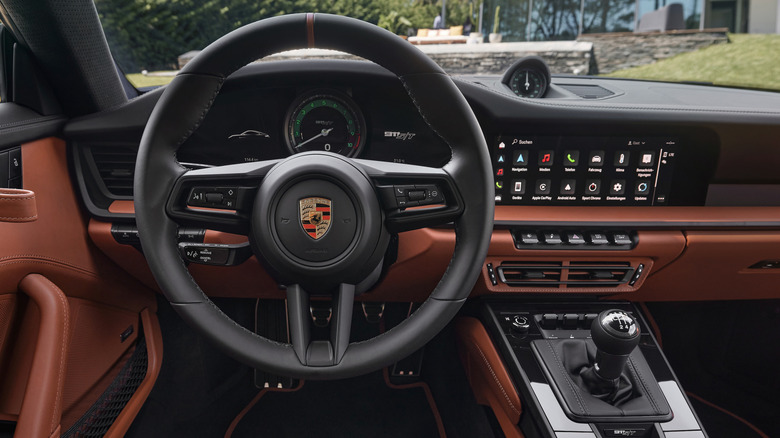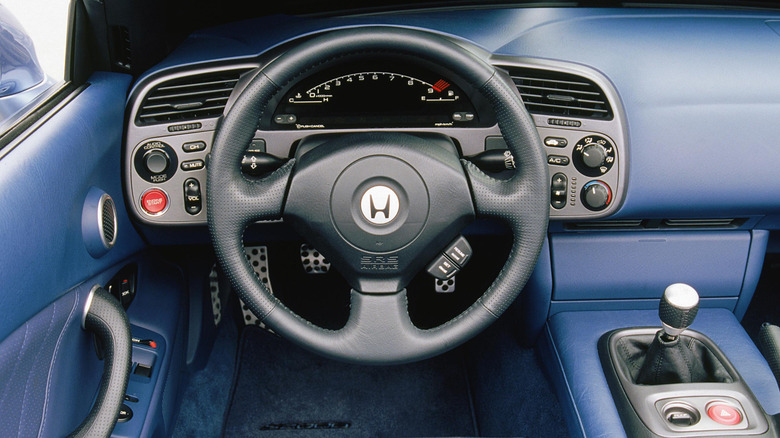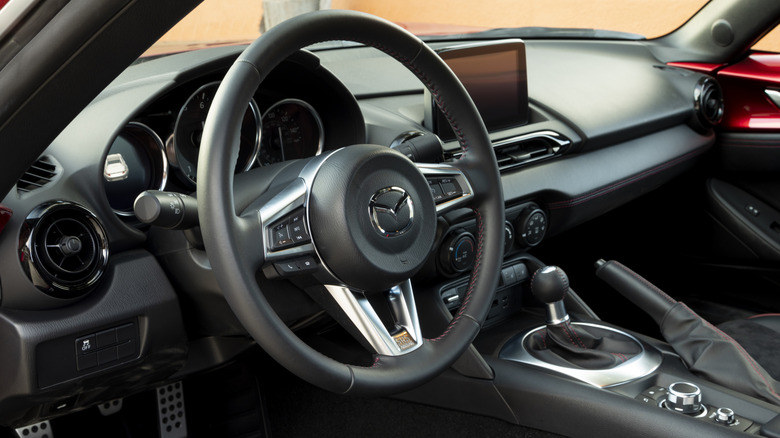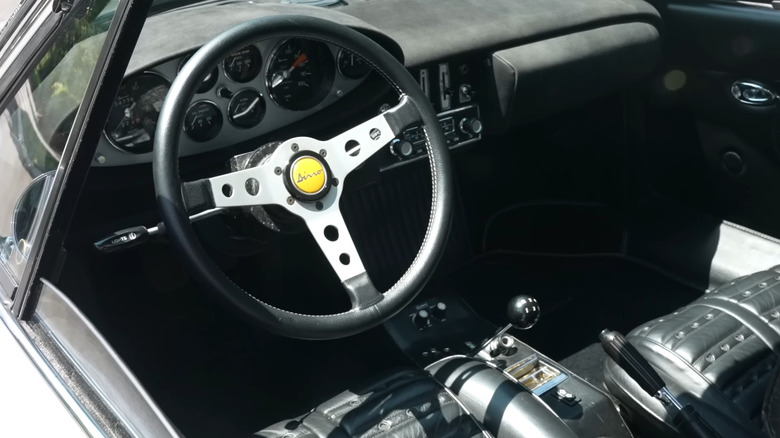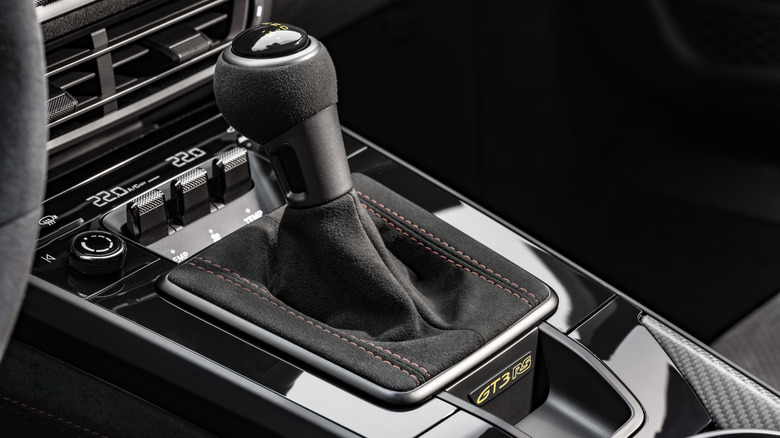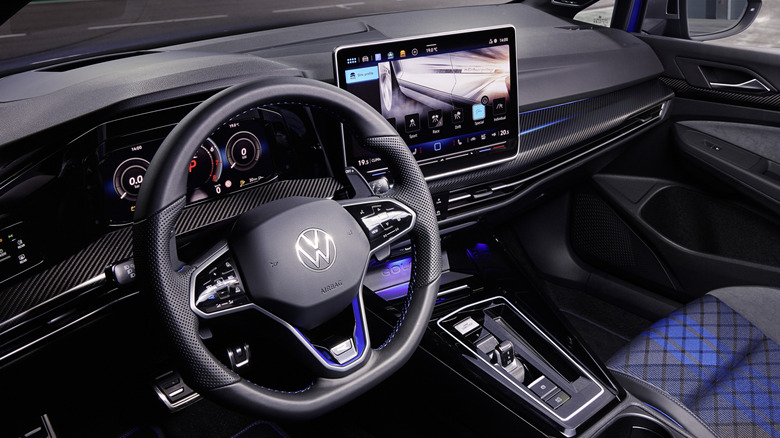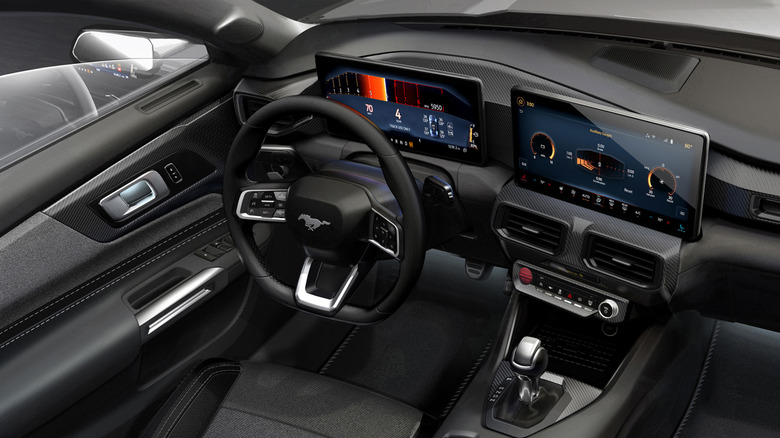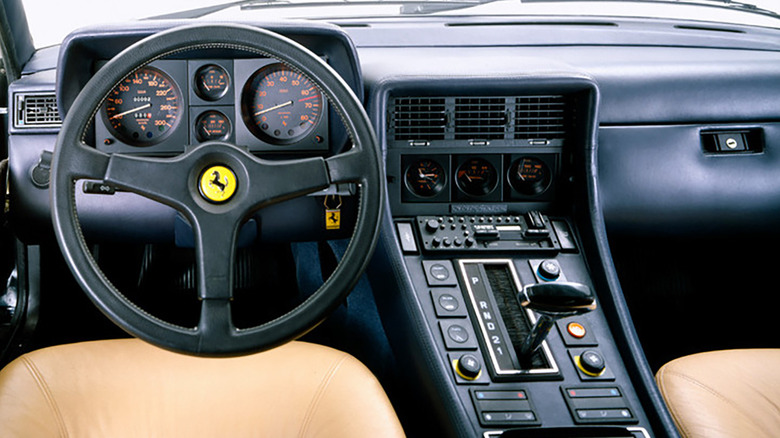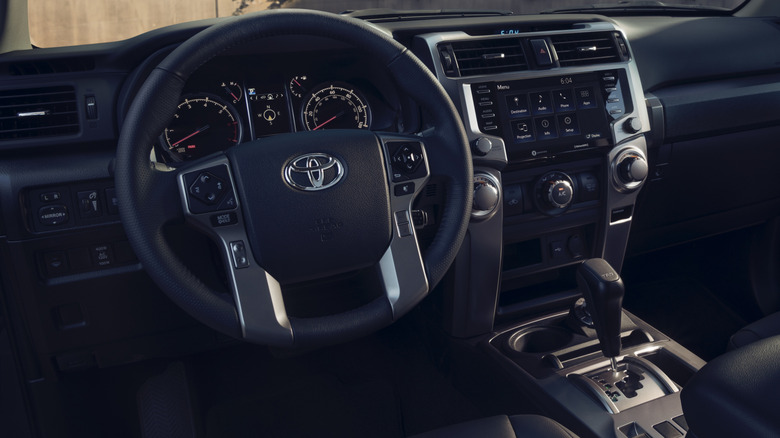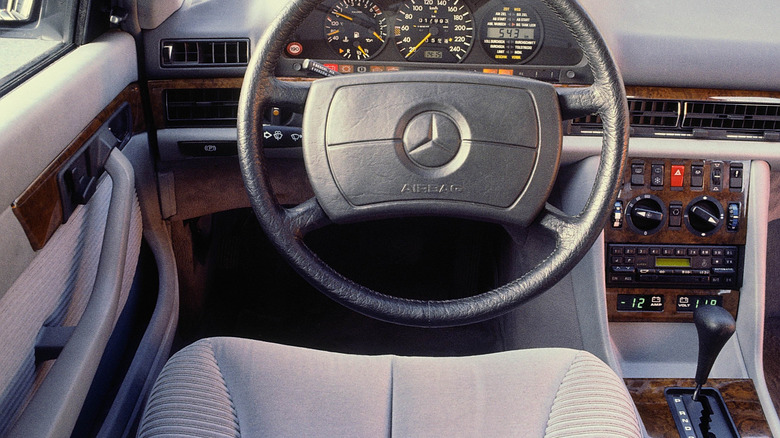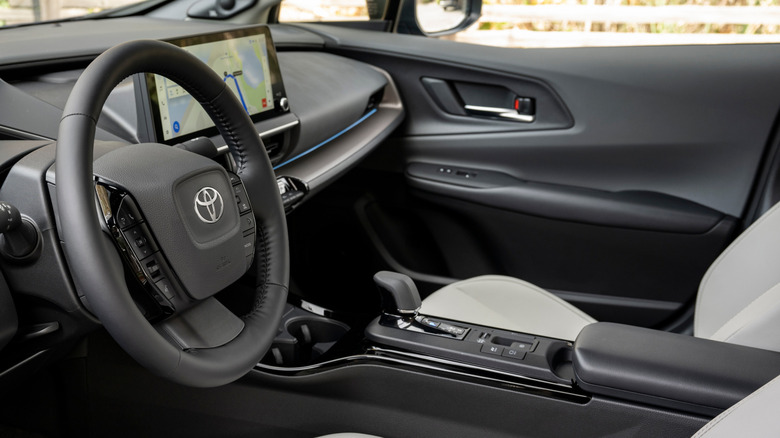12 Of The Best Transmissions Ever Offered On A Production Car
While you'll most commonly hear enthusiasts talk at length about a car's engine, chassis balance, and handling, there is another important component that's not talked about nearly as much — the transmission. An unsung hero of the automotive world, the gearbox is a crucial link between the engine and the chassis, and it can make or break the driving experience. Slow shifts can kill an engine's performance. Rough shifts can make journeys uncomfortable. Imprecise stick shifts are a pain to use.
But can you rate various transmission types? We think it's possible, especially when you set some parameters. In this piece, we'll have a closer look at the best transmissions, with each standing out from the rest because of different qualities. Manual gearboxes will be listed because they are a joy to use, while for automatics, it's the shift quality. Still, we also listed some super-durable gearboxes, which deserve a place for being overbuilt and ready to keep up with the most reliable engines.
Having driven more than 300 cars, I have had first-hand experience with many great gearboxes. I also encountered some sturdy transmissions during my time as a Toyota aftermarket manager, gaining knowledge that I'll share with you in this article. So, from the mechanical feeling of Ferrari's gated shifters to Toyota's indestructible boxes, here are the best transmissions ever offered on a production car.
Porsche 911 S/T Six-Speed Manual
Fewer and fewer vehicles are being offered with a stick shift, but don't let that make you think the glory days of the manual are over. As far as exhilarating driving experiences go in a manual transmission car, nothing beats the brand-new Porsche 911 S/T.
According to many, this is the ultimate 911 — perhaps the best ever made. See, Porsche borrowed most mechanical parts from its 911 GT3 RS track machine, but without the unnecessary bloat. You won't see huge wings on the S/T, or a quick-shifting PDK transmission. What you will see is an additional weight reduction, resulting in a curb weight of 3,056 pounds.
The naturally aspirated 4.0-liter flat-six, of course, is already considered as one of the greatest engines ever produced. Here, it produces an impressive 518 hp, revving to a stratospheric 9,000 rpm and providing an acoustic feast. Porsche also equipped the 911 S/T with a lighter double-disc clutch and single-mass flywheel for lightning-fast throttle response, which means you'll need to be on top of your game when shifting the short-ratio six-speed manual.
According to every journalist, there is a learning curve, but once you master it, the manual will provide you with one of the most visceral experiences. Mechanical, super-precise and with short throws, the 911 S/T's stick shift is a joy to use. It just makes us sad that Porsche will only make 1,963 units and sell them for an astronomical $290,000 before options.
Honda S2000 Six-Speed Manual
Fortunately, you don't need to spend Porsche money to experience manual transmission ecstasy. The Honda S2000 isn't exactly cheap, but a lot more people can afford it, at least. If you are among the lucky ones, you'll get to experience one of the best stick shifts to ever grace a four-wheel machine.
I had the chance to drive a mostly stock S2000 more than a decade ago, and even now, the shifting quality remains a core memory. Super short throws, unmatched precision, and sublime feel. It's mechanical. Tactile. Shifting through the gears feels almost like racking a gun. Basically, it's everything you should want in a manual transmission. And it's not just the stick itself that impresses — the clutch action is on point, too.
Let's also not forget that the S2000 was equipped with one of the best naturally aspirated engines ever made. The 2.0-liter four-cylinder (later 2.2-liter) makes 240 hp and revs to 8,900 and produces the right kind of angry, visceral sound. More than anything, though, it's super responsive, meaning heel-and-toe downshifting is a dream in this car.
Of course, the Honda S2000 isn't one of the most iconic four-cylinder JDM cars just because of its drivetrain. Thanks to the 50:50 weight distribution, the S2000 is fun in the corners, too, aided by the low curb weight of just 2,780 pounds. Early models were a bit twitchy, though, which is one of the things you should know before buying a Honda S2000.
Mazda MX-5 Miata (ND) Six-Speed Manual
The latest MX-5 Miata's manual shifter might not be up to the standard of the S2000, but it gets pretty darn close. The short-throw unit is very precise, with a slick shifting action between the gears. It's not only a true joy to use, but also very easy to use, unlike the shifter in the 911 S/T. A big part of that is the forgiving clutch, which allows even novice drivers to get on top of it quickly.
Still, the six-speed manual is only one ingredient of the Mazda MX-5 Miata recipe for happiness. Yes, it's far from fast, but the 181-hp 2.0-liter four-cylinder is still potent enough for the low curb weight of just 2,454 pounds. Still, it's all about that chassis balance, which allows you to push Mazda's lightweight roadster and carry momentum through the corners. The ND Miata is agile and responsive, almost like a go-kart. Sure, there
It also has superb steering. Responsive, direct, and precise, it allows you to place the MX-5 Miata anywhere you want in the corners. Crucially, it communicates everything with you, which, along with the great manual, makes you feel like you are a part of the car. The best part — it starts at under $30,000, fresh from the dealership. It's should also be cheap in the long run, with a 29 mpg combined rating making it one of the most fuel-efficient sports cars.
Ferrari Dino 246 GT Five-Speed Manual
As with many other car components, few automakers can match the extravagance of a gated Ferrari manual transmission. Precise, deliberate, with a mechanical click akin to a clock ticking, a Ferrari gated manual provides an intimate relation between human and machine. And one of the best gated manuals sits inside the Dino 246 GT — the Prancing Horse's first-ever V6 sports car. Predictably, the Dino 246 GT isn't as fast as V12 Ferraris from the era — its relatively small 2.4-liter V6 only made 192 hp and 167 lb-ft of torque. Even so, thanks to the low curb weight of 2,380 pounds, the Dino reached 60 mph in solid 7.1 seconds.
Behind the wheel, though, the feeling will be more exhilarating than in a modern EV. The 246 GT sounds absolutely wicked — raw, ferocious, and crisp. Each time you let off the gas pedal, a clicky five-speed stick shift provides mechanical rhythm to the V6 music. It has a longer throw than modern manuals and heavier action, but that only adds to the experience. Oh, and the first gear is on a dogleg, allowing quicker shifting between second and third while you are driving on a twisty road. Keep in mind that the Dino 246 GT is also mid-engined, which allows for agile, delicate handling. The fact that it's one of the best-looking Ferraris ever only adds to its appeal.
ZF 8HP Torque-Converter Automatic
Unless you've been sleeping under a rock the past few years, you are probably familiar with ZF's eight-speed automatic transmission. This advanced torque-converter gearbox has become almost ubiquitous in modern premium vehicles. You'll find it in BMWs and Audis, but also Jeeps and Hellcats. It works with mild-hybrid or plug-in hybrid powertrains. Heck, it's even in Rolls-Royce luxury yachts and Aston Martin or Maserati sports cars.
That last part is the reason why the ZF 8HP is the best automatic transmission on sale today. It's buttery smooth, but also very quick, making it a great addition to pretty much any vehicle. To achieve this transmission excellence, ZF equipped the 8HP with five shift elements for four gear sets. Crucially, it only has three multi-disc clutches and two open shift elements per gear to minimize losses and increase fuel economy. Still, ZF says that the quality of the solenoids and control software are the components that allow for the smooth, yet lightning-quick gear shifts.
Unsurprisingly, we tried ZF's masterpiece in multiple models. During her first drive of the BMW M4 CSL, our own Victoria Scott found that the eight-speed provided rapid and violent gearshifts, similar to a dual-clutch transmission. Meanwhile, our own Cameron Aubernon found that it worked well in his review of the plug-in hybrid powertrain of the Jeep Wrangler 4xe. You really can't go wrong with the ZF 8HP.
Porsche PDK Dual Clutch Automatic
Porsche was the first automaker to use a dual-clutch transmission in the 956 endurance race car, though it was beat to the punch by Audi for a production car. Even so, it's safe to say that Porsche perfected this transmission type; called PDK, it graces everything from a regular 911 to the 911 GT3 RS race car for the road. It's also available in seven-speed or eight-speed configuration, depending on the vehicle.
And in our first drive of the Porsche 911 GT3 RS, we found it to be a prime example of how good Porsche's PDK really is. Lightning-quick reaction to the driver's input. Even faster gear changes with no torque interruption. Ease of use that stick-shift drivers could dream of. Undoubtedly, it's the best high-performance transmission in a road car. It's all thanks to the inherent swiftness of dual-clutch transmissions, which always have the next gear preselected using two clutches. As a result, despite being heavier than a manual transmission, the PDK offers significant performance benefits, like shorter acceleration times.
Still, Porsche's PDK transmission isn't here only because it's quick; most dual-clutch transmissions are. See, these gearboxes can be jerky during gear changes, particularly when driven sedately. Moreover, early units were slow to shift to a gear that wasn't preselected by the transmission. Not Porsche's PDK, though. It selects any gear seemingly at light speed, while also being smooth during gear changes.
Audi/Volkswagen DSG/S-Tronic Dual Borg Warner Clutch Automatic
Porsche might be at the forefront of dual-clutch innovation, but the VW Group's impact shouldn't be underestimated. The conglomerate was the first to put the Borg Warner gearbox in a production car — the 2003 Audi TT 3.2 V6. Audi called it S-Tronic then, but Volkswagen chose DSG (Direct Shift Gearbox) when it launched the gearbox in the Golf MK4 R32. At that time, VW's dual-clutch transmissions had six speeds, though later a seven-speed unit was developed.
Remember, this is during the 2000s, when other automakers offered ancient torque-converter automatics. The dual-clutch transmission was truly a revelation, closing the performance gap between to the manual transmission. Immediately, DSG-equipped cars were quicker than the manual alternatives, as opposed to the aging torque-converter automatics. The DSG/S-Tronic was also relatively smooth, particularly when compared to single-clutch automated manuals like the one found in the BMW E60 M5.
Still, the biggest victory for VW's transmission was its ubiquity. VW Group quickly started putting it in all sorts of cars, even in low-cost city cars like the 2010 Skoda Fabia with a 1.2-liter, 105 hp engine. I remember trying it in this exact car back then and came out astonished by the F1-like shifting speed. It felt like the future. Heck, it was even better than some automatic luxury cars from the era. The fact that it also improved fuel efficiency was only the icing on the cake.
Ford/GM 10R80 10-Speed Automatic
American automakers also have a modern automatic transmission they can be proud of. The 10-speed auto, co-developed by Ford and GM, is an advanced gearbox that does its job exceptionally well. Crucially, just like the ZF 8HP and VW's DSG, it is used in a plethora of models, from full-size pickup trucks to muscle cars. The latest Ford F-150 Raptor R and Tremor use this transmission. So does the 2025 Ford Mustang EcoBoost with a four-cylinder engine.
Interestingly, Ford/GM's 10R80 transmission utilizes incredibly tightly packed gear ratios, with a smaller spread than other multi-gear gearboxes. These always keep the engine in its sweet spot, allowing for greater performance and fuel efficiency. Shorter spacing between gear ratios makes them useful for towing as well. Meanwhile, the shorter final gear means that the transmission will utilize it more often than its rivals.
Important for muscle car fanatics, the 10R80 also provides quicker gear changes and acceleration times than a manual transmission. Thanks to the new electric solenoids, it can also skip shifts, like from eighth to third gear, allowing even greater performance benefits. It can do the same when upshifting, improving fuel economy. Sure, it's less engaging than a stick shift, but the same is true for any automatic. Crucially, the 10R80 is a well-tuned transmission that works well with various driving styles, particularly in newer models, like the Ford Mustang Dark Horse.
GM TH400 Three-Speed Automatic
With General Motors' TH400 longitudinal three-speed automatic, we are having a change of pace. Instead of shift quality, it's reliability and toughness that take center stage here. Introduced in 1964, the TH400 was a big deal at the time, replacing GM's aging ST300 two-speed automatic. It was more advanced, with a pitch stator (Turbo HydraMatic model) that allowed for changing the shifting characteristics, though reliability is what made it famous.
Predictably, GM started putting it in most of its larger luxury vehicles, like Chevrolets, Buicks, Oldsmobiles, and Cadillacs. By 1970, though, the TH400 started being used in the corporation's heavy-duty trucks. It was all thanks to its legendary toughness; the TH400 was rated at 450 lb-ft of input torque, which was quite high for the era. Still, that was quite a conservative rating that was easily surpassed with a few aftermarket mods. The TH400 also worked with RWD and AWD
Thanks to that, other automakers quickly rushed to GM to get a TH400 for their models. Jaguar and Rolls-Royce used this transmission, and surprisingly, so did Ferrari in its 412 grand tourer with a V12 engine. You can even adapt it for use in high-horsepower modern engines, provided you are okay with having only three gears.
Toyota A750 Five-Speed Automatic
In SlashGear's review of the 2023 Toyota 4Runner, colleague Steven Ewing called it an automotive anachronism, and he was spot on. Toyota's aging SUV at the time couldn't keep up with its rivals in terms of, well, everything, and this included the five-speed automatic transmission. Buttery smooth, but very slow and hesitant to kick down a gear, Toyota's A750 looked way behind the times just two years ago.
Still, as you'd expect from a Toyota component, the A750 is one of the most reliable transmissions ever made. Bulletproof, even. The fact that the A750 has a simpler, old-school design makes it more durable, but of course, Toyota's know-how in creating reliable components also plays a part. On average, the A750 should be good for at least 400,000 miles before a rebuild, even on vehicles used for heavy-duty tasks. Its solenoids are the only fragile part, and they are cheap and easy to replace. All other components are sturdy and up to Toyota standards.
Launched in 2003, the A750 comes in two flavors: the A750E for RWD vehicles, and A750F for AWD vehicles. It was used mainly on Toyota's SUVs, like the 4Runner and Land Cruiser, but also the Lexus GX470 and LX470, paired with V6 and V8 engines.
Mercedes-Benz 722.3/722.4 Four-Speed Automatic
Way before Toyota was associated with reliability, Mercedes-Benz was who people felt made the most durable vehicles. The OM617 inline-five diesel is often considered as one of the most reliable engines ever made, with a Greek taxi driver taking it to an astonishing 2.85 million miles.
Still, Merc's engineering prowess is also evident in the 722.3 and 722.4 four-speed automatic transmissions, which are also among the most durable in automotive history. Hitting 450,000 miles before a rebuild is almost given with these units, with many examples surpassing the million kilometer mark (620,000 miles).
Mercedes-Benz used both these transmissions in its rear-wheel drive sedans, like the W124 E-Class and 190-Series. It was available with the automaker's four, five, and six-cylinder gas and diesel engines. The 722.3 was designed for more powerful models, able to sustain up to 420 lb-ft of torque. Meanwhile, the 722.4 was good for up to 184 lb-ft of torque.
Although tough, the 722.3 and 722.4 transmissions of course aren't the last call in technology, and they shifted through the gears quite slowly, something I recall from my cousin's W124 diesel. Still, they are generally smooth, and perfectly in line with the luxury credentials of Merc's sedans.
Toyota e-CVT Planetary Gearset
Continuously variable transmissions (CVTs) are admittedly not very popular among the enthusiast crowd. You'll often hear complaints about a rubber-band feel during acceleration and a constant drone by the engine. These characteristics also apply to Toyota's e-CVT (the e is for electric), which is fitted into most of the company's hybrid models.
However, while regular CVTs are not very durable, the e-CVT is a whole different story. Instead of pulleys and belts/chains, Toyota's hybrid-only transmission uses a planetary gear set to constantly vary the gear ratio. While driving, they behave similarly, but the planetary gear set is way sturdier.
In my three-year experience as an aftermarket manager at a Toyota dealership, I never encountered a faulty e-CVT. Not once. Also, I heard the same is true from people in other European countries. Reliability surveys have also confirmed that Toyota's hybrids are very reliable in general, despite their complexity.
The fact that e-CVTs have an infinite number of gear ratios means that they always keep the engine in its most efficient rpm range. Moreover, the planetary gear set can be disconnected from the internal combustion engine for EV-only driving. Unsurprisingly, the latest 2025 Toyota Prius gets a class-leading efficiency rating of 57-mpg combined. That's impressive once you find out that the Prius also has 194 hp and gets to 60 in 7.2 seconds.
